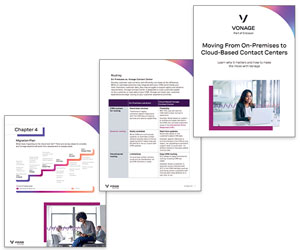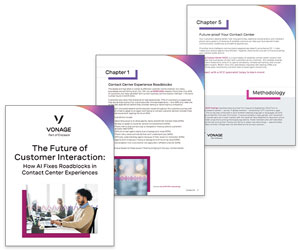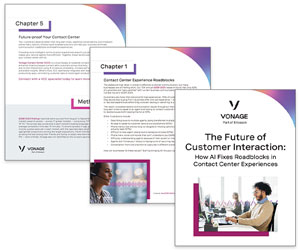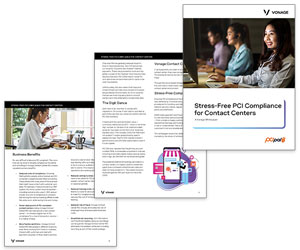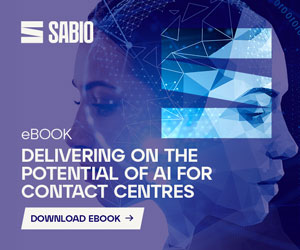Ryan Yee on behalf of Vonage explores what omnichannel call centre and contact centre actually mean, what to look for from omnichannel call and contact centre solutions and, strategies to make the most of them.
What’s the Difference Between a Call Centre And a Contact Centre?
Let’s consider the phrases “omnichannel call centres” and “omnichannel contact centres.” They’re both composed of two principal elements – the “call/contact centre” part and the “omnichannel” part.
Before we get to the complexities of omnichannel, let’s recap the difference between a call centre and a contact centre.
A call centre – in a customer service context – is an organization or department within an organization dedicated to answering inbound calls.
Those calls are usually from customers seeking answers to questions or help with issues from customer service representatives.
A contact centre is similar except that it caters to more communication channels. Contact centre agents may well still answer phone calls from customers, but could also respond to emails, interact with customers via live chat, and more.
What Precisely Does ‘Omnichannel’ Mean?
Now onto the slightly more nuanced definition that’s needed to fully understand terms like “omnichannel service call centre” or “omnichannel contact centre solution.”
Omnichannel is a term used to describe the seamless provision of a positive customer experience across channels of interaction.
The idea is that regardless of the channel on which they reach out, a customer will receive the same excellent level of support.
More than that, customers should be able to start an interaction on one channel and then seamlessly continue it on another.
The idea is that an omnichannel customer experience is a holistic one which meets customers where they are, on their preferred channels.
So, Can There Be Such a Thing As An Omnichannel Call Centre Solution?
What you’re probably wondering right now is “doesn’t that mean there’s no such thing as omnichannel call centre services?” And the answer to that is, yes, technically an omnichannel call centre is a misnomer.
If a centre provides seamless support to customers across a range of different channels it is – by definition – both “omnichannel” and a “contact centre.”
You’ll still hear and read plenty about “omnichannel call centres”, though. That’s because – while technically incorrect – it is still used and understood as a kind of synonym for an omnichannel contact centre.
What is An Omnichannel Contact Centre?
In essence, then, an omnichannel contact centre is a customer service function whereby customers can reach out to and interact with a business via multiple channels. Crucially, too, the service they receive will be of the same high standard regardless of which channel (or combination of channels) they choose.
An omnichannel contact center allows customers to reach out from any device or communication service they want, without the business losing track of who they’re talking to on the other end.
The basic idea is simple: Customers expect a fluid experience across all of their devices, even in their support and sales interactions. An omnichannel contact centre supports this expectation.
How Do Omnichannel Contact Centres Work?
Omnichannel contact centres work by bringing all the channels a business wishes to use for customer interactions onto one platform.
Agents are empowered to meet customers where they are and help them in the way that’s most convenient for the customer at any given time.
Omni – meaning “all” – therefore, is the key to realizing what these contact canters are capable of. Think about your smartphone as just one example: There are a lot of ways to communicate on it – SMS, email, internet browsers, apps, chats, social media, and, of course, making a traditional call.
An omnichannel contact centre coordinates as many of these avenues as it can with a singular set of agents fielding the calls, pings, texts, and emails.
A customer might email, send your company a Facebook message, send the chatbot on your website a quick message via their phone’s web browser, or do something else entirely.
With an omnichannel contact centre, you’re making sure you can always get the message and always match the customer on the other end with the right account.
What’s more, the best omnichannel contact centre solutions also integrate with a business’s customer relationship management (CRM) platforms. This ensures that agents have ready access to all customer information and prior interactions.
Multichannel vs. Omnichannel Contact Centres
You thought you were done with the definitions and comparisons now that we’ve gone past our omnichannel call centre discussion, right?
Well, not quite. It’s also worth taking a moment to consider multichannel vs omnichannel contact centres and how they differ.
Just like omnichannel call centers, the multichannel alternative also allows customers to reach out via different channels. The key difference, however, is that in a multichannel contact center those channels are siloed and handled separately.
If a customer starts a live chat conversation and then makes a phone call, a multichannel center won’t be able to connect the dots.
The customer would have to repeat themselves to the agent on the phone. In an omnichannel scenario, meanwhile, the agent who answers the phone would be able to access the prior live chat to make the customer’s experience seamless.
What Are the Benefits of an Omnichannel Contact Centre?
So, that covers what an omnichannel contact centre is, how it works, and why it’s not technically correct to talk about omnichannel call centre technology. What, then, about the business benefits of implementing an omnichannel contact centre?
Businesses and their customers stand to gain a lot of value with the omnichannel solutions found in a contact centre.
Here are just three of the most notable benefits:
- Seamless conversations with customers
- Quick responses to reputational threats
- Whole-business and all-customer alignment
Continual Conversations With Customers
When a customer starts a conversation with a chatbot or person through a website or an app, there’s a chance they’ll need to switch channels at some point.
Terminating the conversation and starting from scratch later can be frustrating. A busy customer would much rather use a different channel that’s more convenient during their next move.
That reflects one of the most important aspects of omnichannel customer communication: When the customer continues the conversation five minutes or five days later, they aren’t being moved to a different department by virtue of changing channels – and all the pertinent data is right there for the rep they contact.
Quick Response to Reputational Threats
Omnichannel also gives your business more control and flexibility as it scans social media for conversations about the company, its products, and its services.
Social media sentiment analysis can determine which posts express a particularly high level of frustration and prioritize them for a quick resolution.
Likewise, the capability can route a request to a specific representative with precisely the right experience to resolve the problem right away.
And, crucially, it gives that representative a wealth of data about that customer’s past interactions with the business. This ultimately helps your teams provide the effective, personalized service that customers have come to expect – even if the interaction starts out negative.
Whole-Business and All-Customer Alignment
Customers aren’t the only ones who benefit from an omnichannel contact centre solution. It’s also an increasingly beneficial presence for line-level service reps, their managers, and the executives overseeing it all.
For representatives: Customer service agents get a fuller view of the customer’s entire history with the company.
This crucial context may include anything from order history to the sentiment the customer displayed on their last several calls and can provide the agent with all the on-the-fly data they need to make the right decision immediately.
For managers, executives, and high-level stakeholders: Managers may need to review individual call transcripts or review performance by segment or block of time.
Likewise, executives routinely need a big-picture view so they can make strategic decisions. An AI-enabled omnichannel contact centre enables both, providing relevant performance and interaction metrics to the right eyes.
What Features Do You Need From an Omnichannel Contact Centre?
So, you might be convinced by the merits of providing an omnichannel customer experience. If so, you’re probably thinking about which software solution can help you do so.
Every solution you explore will offer different feature sets and overall capabilities. One of your most important jobs as a business looking to upgrade is understanding exactly what’s available to you and how it fits with your business model.
Here are a few examples of key capabilities to be on the lookout for:
- Smart inbound routing
- Integrated customer engagement history and other data
- Cloud-based administration and iterative improvements
Smart inbound routing
In our 2025 Global Customer Engagement Report, omnichannel statistics showed customers get tripped up by the communications problems found at some companies.
They’re also not too pleased with carryovers from the days of highly regimented service systems, such as long wait times and difficulty finding the right person to answer their questions.
Smarter inbound routing tools, specifically ones powered by artificial intelligence (AI) that integrate directly with your omnichannel contact centre, can help solve these issues.
By building them into your communications stack from the start, you give your business the best chance to get off on the right foot with customers engaged in an omnichannel life.
Integrated Customer Engagement History and Other Data
Today’s omnichannel contact centres provide businesses and their customers with a turnkey every-channel experience.
That includes integration with popular customer relationship management (CRM) systems like Salesforce. More specifically, you want a solution that captures vital customer data and lets you share relevant aspects of it across the company.
As noted, AI integration can provide an advanced level of utility with this. Having a built-in tool that turns speech to text, analyses conversations for sentiment, and automatically links contacts to cases – plus links all of this data to the right account every time – can shave several minutes off interaction times and let your agents focus on taking care of people with the right data at hand. And that’s on top of the intelligent routing capabilities mentioned previously.
Cloud-Based Administration and Iterative Improvements
In the old days of communications technology, adding “simple” features required technicians to go to sites and install hardware. Today, it’s much more seamless for the business and the customer.
Because many platforms now run everything over the cloud, upscaling the operation, adding whole new communication channels, and integrating with new tools as they come along are significantly easier to manage.
This is increasingly important in the world of communication, where customer whims can change both quickly and permanently. When buyers move to the next big communications platform, a cloud-based omnichannel contact centre solution ensures you can quickly meet them there.
Leaving Behind the Call Centre: Omnichannel Strategies to Make the Most of a Contact Centre
Once you’ve got your omnichannel contact centre solution in place, you need to know how to make the best use of it. The following are just three examples of some best practices when it comes to omnichannel service provision:
Truly understand your customers and their friction points. This will help you devise ways to overcome problem areas and fully earn customers’ trust.
Streamline areas of your experience. Talking with customers and third-party partners can give you a high-level view of what you’re doing right and what could stand some improvement.
Determine the channels to be in now, and in the near future. Understanding this can help you realize the full stack of solutions you’ll need to get to where you want to be.
This blog post has been re-published by kind permission of Vonage – View the Original Article
For more information about Vonage - visit the Vonage Website
Call Centre Helper is not responsible for the content of these guest blog posts. The opinions expressed in this article are those of the author, and do not necessarily reflect those of Call Centre Helper.
Author: Vonage
Reviewed by: Megan Jones
Published On: 5th May 2025 - Last modified: 15th May 2025
Read more about - Guest Blogs, Vonage






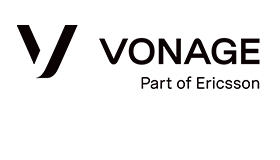 Vonage is redefining business communications, helping enterprises use fully-integrated unified communications, contact centre and programmable communications solutions via APIs.
Vonage is redefining business communications, helping enterprises use fully-integrated unified communications, contact centre and programmable communications solutions via APIs. 




